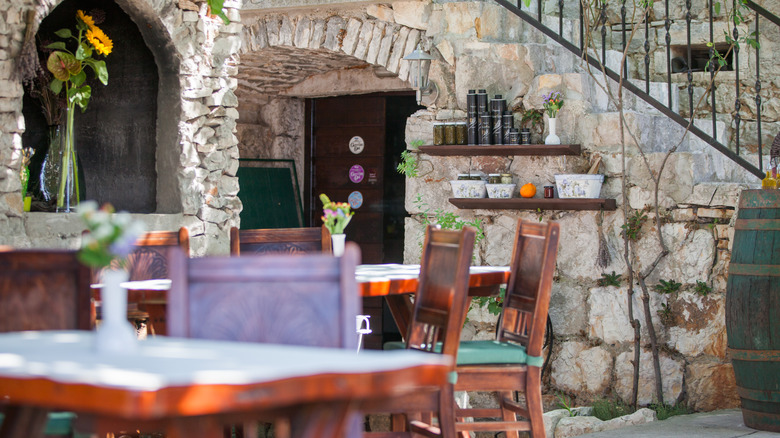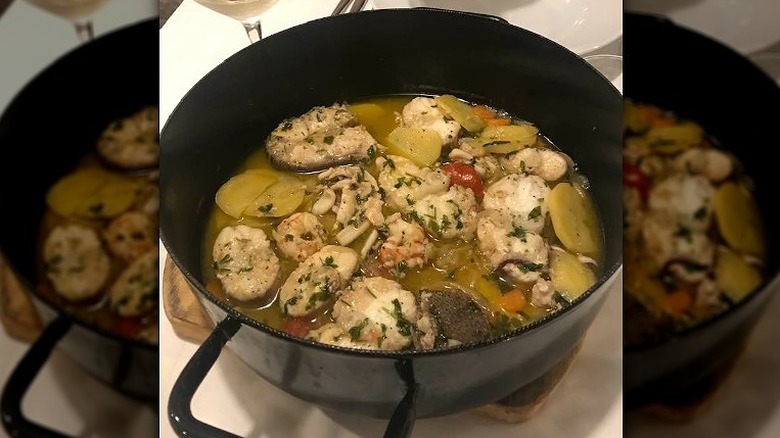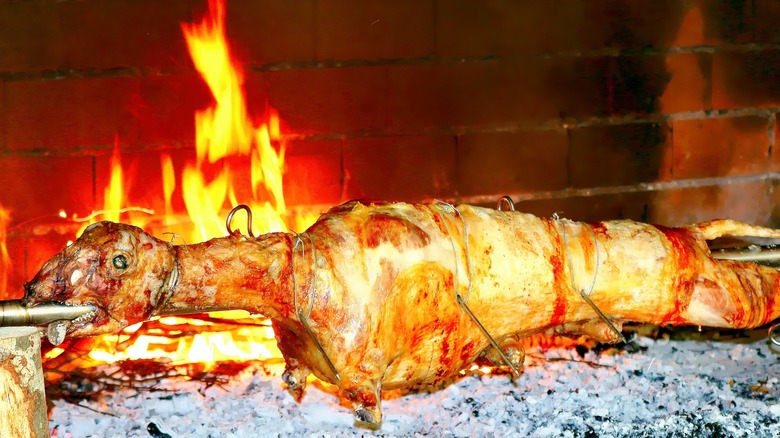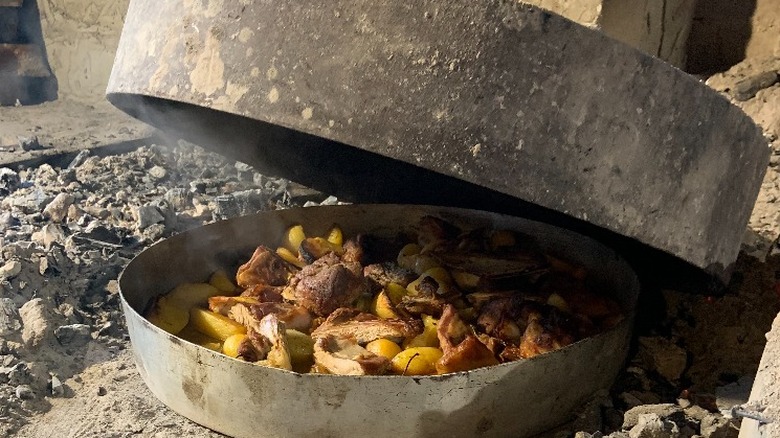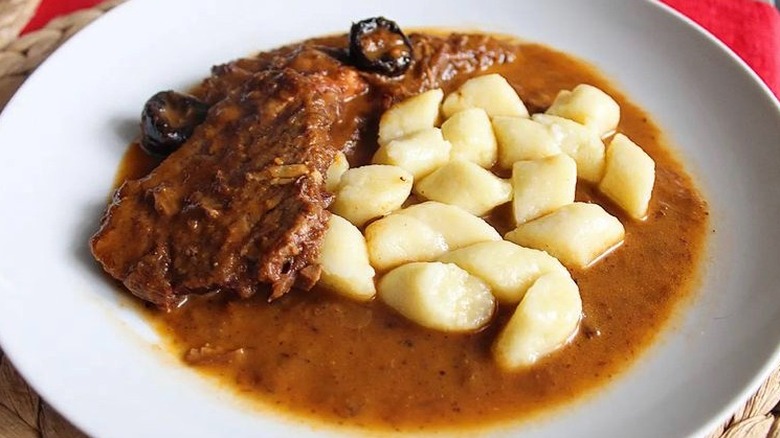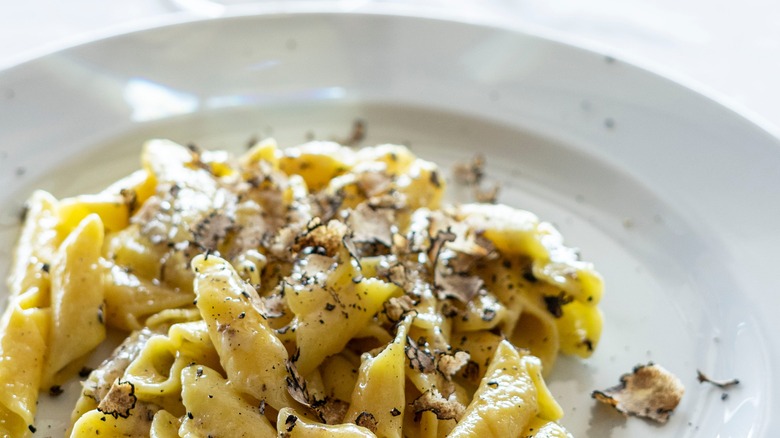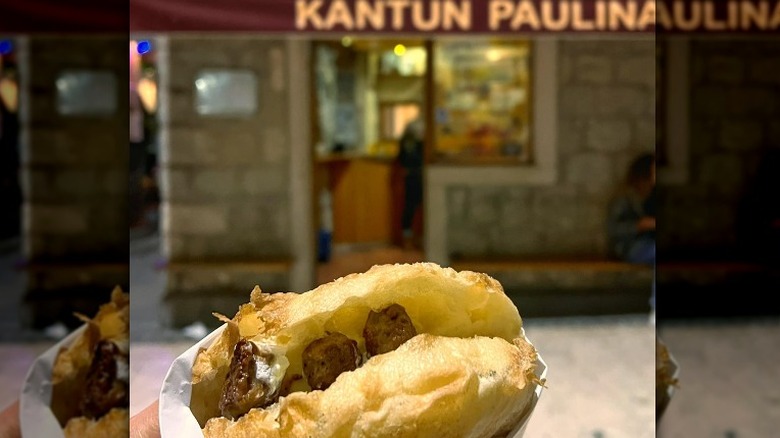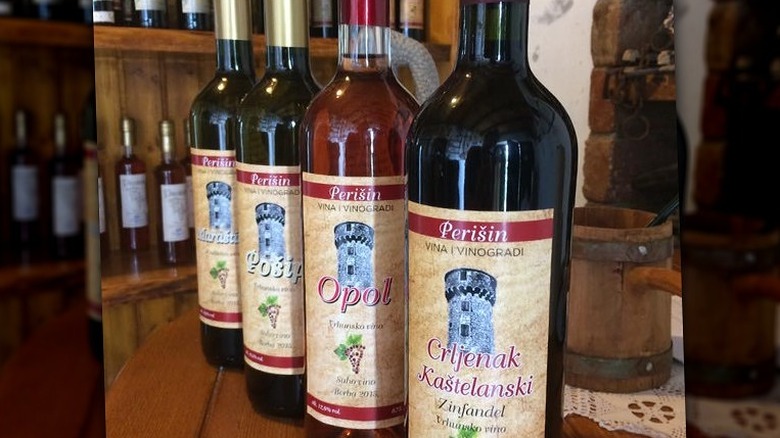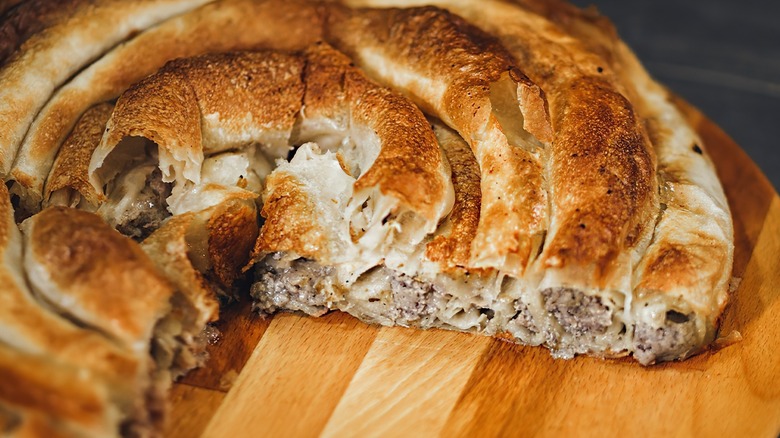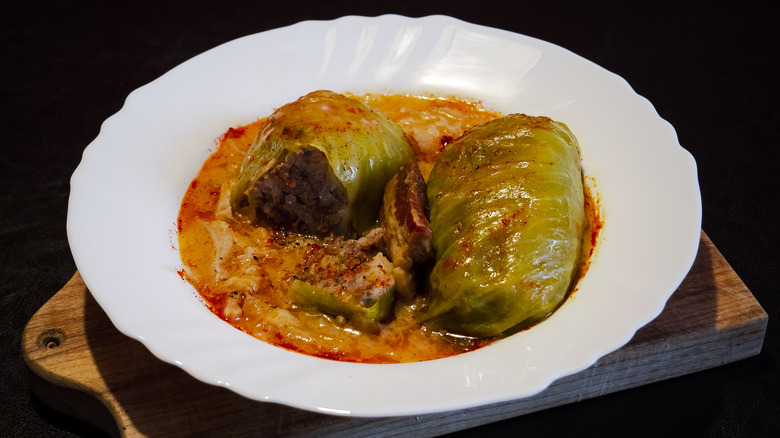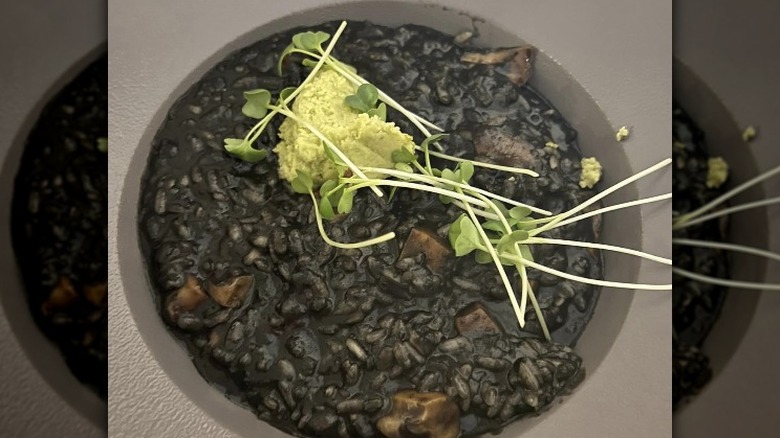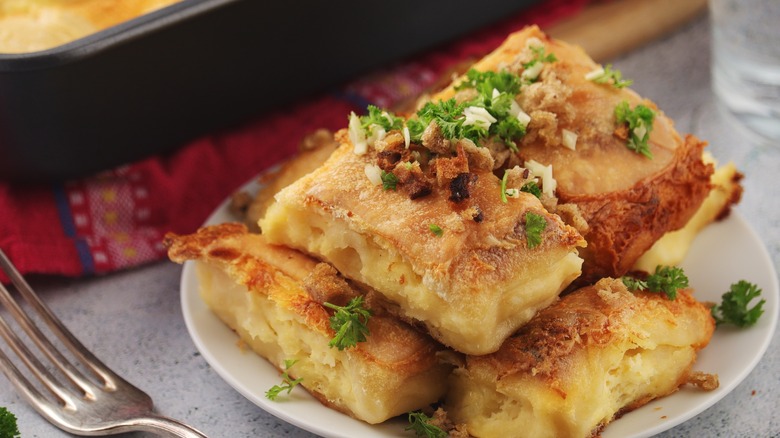12 Foods And Drinks You Have To Try In Croatia
When it comes to Croatia, the secret of the country's natural beauty has been out for a long time. What's maybe less well known is the culinary delights on offer. Since Croatia shares a border with several neighbors, the individual nuances of the country's culinary landscape can get lost. But, step off a plane, a boat, or an automobile that's arrived on Croatian soil, and the gastronomic scene is thrust at you immediately. The food and drinks you have to try when visiting Croatia are authentic, earnest, and entwined with the cultural heritage of the Adriatic state.
In Croatia, every meal is taken care of. Need breakfast? There's a pekara (bakery) on every corner offering multitudes of warm pastries; the white stone konobas serve low-cost lunchtime meals known marende, shifting into heartier plates for dinner. And there are just as many gelato shops ready to satisfy your sweet tooth. Don't worry about something to wash it all down with, either — Croatia is known for an abundance of fine local wines, yeoman beers, and home-crafted liquors. If you're in search of your next food tour destination, look no further than this.
Gregada
Great portions of Croatia are covered in mountains, but many Adriatic Sea islands make up the Balkan nation as well. The coastal towns and villages have played an important part in the development of regional sea trade for centuries, evolving unique histories, traditions, and cultures with each passing ship — especially around food. The island of Hvar, and the eponymously named town, is one such area where local customs have flourished to become an important thread in the tapestry of Croatia's national foodways. The dish gregada is an example.
Gregada is a Croatian meal known as a Dalmatian specialty, though it has far outgrown a home on Hvar and can now be found all along the Adriatic Coast. To make gregada, a base of white wine, aromatic alliums like garlic, celery, capers, and parsley are stewed together with potatoes and white fish. The result is something like summer dripping off your fork. When eating gregada, you should expect that the succulent fish is a fresh catch — especially on Hvar. You should also look for a pile of fresh bread so you can soak up the bright sauce at the bottom of the pan.
The best version of this simple stew we've tasted throughout our travel to Croatia is found at Dva Ribara. If you find yourself around during the warmer months, make sure to give the gregada a try.
Paška janjetina (Pag lamb)
Look on a map, and you can see that the island of Pag is a fairly desolate-looking place. The level of vegetation covering the landscape seems sparse from above, and so you could be forgiven for expecting little from this island moonscape-like place. Yet, Pag island is actually a treasure trove of hidden gastronomic wonders. Goods like salt, honey, and cheese are all well-reputed, with flavors developed from the unique combination of ground herbs and sea salt that intersect on the island. Another luxurious food developed from the island's ecosystem? Lamb. Pag lambs, which forage on these salt-soaked herbs, are a free-ranging species that have garnered a Protected Designation of Origin (PDO) since 2015.
Pag lambs are harvested when they are under 45 days old, a practice that ensures the meat of the livestock remains at its most tender. Typically, the selected animals weigh between 4 to 10 kilograms (8.8 to 22 pounds). Pag lamb can run a pretty penny in markets or on restaurant menus, as it is considered a fine delicacy. Beyond its limited availability, the meat's natural salinity and mineral herbaceous notes definitely bolster that status.
Traditionally, the lambs are chosen for slaughter in the winter months between January and March. Spit-roasted Pag lamb is a customary way to have it cooked, giving the meat an accentuated depth of smokey, charred flavor.
Peka
It is said that the origins of peka can be traced back over 5,000 years. Though there is an abundance of ways to doctor the slow-cooked dish to your liking, many Croatians cook it with seafood (octopus is a staple, as seen in season 6 of "Somebody Feed Phil"). However, we recommend seeking out the traditional version which consists of a giant dish of steaming pork, beef, and lamb. The meats are tender on the tongue and ripe with deep, smokey flavors.
Uniquely enough, peka is not just the meal but the cooking process itself, as the name "ispod peke" translates to "cooking underneath a bell" which reflects the lid of the dish's cooking vessel. Once filled with ingredients, a peka dish is topped with that large dome-shaped lid and then cocooned in smoldering hardwood coals. (Think of it as a sweat lodge for food.) The combination of meat or seafood, potatoes and carrots, onion, garlic, pepper, olive oil, and loads of herbs and seasonings cooks for hours on end. In the case of our favorite peka from Konoba Bajso, a local friend had to place our dinner order early in the morning, and there was still time for appetizers after arriving for the reservation.
Pašticada
Some might consider peka the supreme Croatian comfort food, but for us, a key qualifier for that title is the inclusion of some form of pasta. With that in mind, pašticada makes the cut. The food is as tranquilizing as it gets; cuts of steak, such as round steak, are stewed (notice a trend here?) with red wine, vinegar, and hearty additions like carrots, onion, and garlic. It is then seasoned with a fair share of herbs (rosemary and laurel are regulars), spices, and lard or pancetta. The result is a rich brown sauce brimming with salinity, earthiness, and a slightly sweet, tangy finish. To temper the bold and varied notes, plain gnocchi is paired with the meat. It serves a dual-purpose, giving a neutral balance and acting as little pillows to sop up the mouthwatering mix.
Pašticada is more than a simple agrarian plate; it's the type of food that tells a history. Recipes for pašticada can be traced throughout Croatia's scattered rule by Romans and Venetians, with the latter group actually using horse meat when making the dish. Croatian pašticada uses beef or veal, though often the chosen cut is one from the cow's hind leg, where lean meat and minimal fat mirror the composition of equine proteins. These days, you're likely to find pašticada in many konobas across the country, though there's a special place for it in the heart of Dalmatians.
Istrian fuži with truffles
The world is full of different pasta shapes. It's only right that a cuisine culture as individual as Croatia's would have its own. Fuži is a traditional pasta of the Istrian peninsula, the northwestern region of Croatia that now borders Slovenia and which was had a tenuous history of Italian/Austrian rule over the years. As such, Italian cuisine plays a big influence in Istria. Foodstuffs like fuži have grown to become some of the most popular pastas to make at home. Fuži is crafted in large sheets which are then cut into a diamond shape, hand-rolled, and pressed into a narrow center. In becoming the base for its most popular form, the pasta is dressed with another Istrian delicacy: truffles.
Istria has a lot of things going for it when it comes to truffles. Not only is the area full of avid mushroom hunters and chefs that are eager to prepare the forage in any way possible, but the conditions for a homegrown market are ripe. Packed thickets of hardwood oak, pine, and hazelnut trees — along with high-humidity soil — offer excellent growing conditions. Fuži and Istrian truffles marry under these circumstances: A cream sauce is infused with the mushroom's unctuous flavor, fuži is smothered in it, and dried bits are then shaved over the top. The result is otherworldly and may leave you questioning which country in Europe deserves the most recognition for its pasta prowess.
Ćevapi
Some Balkan foods transcend the cultural and ethnic disputes of the region, with claim for them belonging at once to each nation and no individual nation. True, ćevapi can be found in Montenegro or Kosovo; it's considered a customary Serbian dish; and shops in Bosnia & Herzegovina are known to sling it; but for our purposes, ćevapi is a food you absolutely have to try when visiting Croatia.
There are a few different ways that you can eat ćevapi, but the most important thing is that you just do it. Eat ćevapi, and eat all that you can. These little skinless sausages, (made of pork, beef, or both,) come in orders of five, or 10, or even more if you can manage. The mince meat links are grilled, then stuffed in a warm pillow of lepinja, a yeasted flatbread-like pita.
Soft and zesty kajmak cheese, chopped onions, and the bite of red pepper laced ajvar spread are all common toppings to dress up the mineral, meaty flavors of your ćevapi — especially when ordering from stand-and-go cantinas like Kantun Paulina, located in Split, Croatia. Banjalučki ćevapi, or ćevapi served in a full block is also possible to find — if you're into that sort of thing.
Crljenak Kaštelanski (Zinfandel wine)
Few wines in America's history have had a reputation makeover like zinfandel. The grape had an exciting period of growth throughout the 1800s, when, per VinePair, it went from a table snack in Boston to a mass-market planting by Californian viticulturists. When white zinfandel emerged on the scene, the black grape's prestige sank to new lows, unfairly lumped into a punchline by high-browed drinkers. In the early aughts, a new age of democratization in specialty wine occurred and suddenly zinfandel was welcomed back. Nowadays, many enthusiasts believe it's one of the best red wines around, and while it certainly has a special place in America, we owe this grape to Croatia.
In Croatia, zinfandel is known as crljenak kaštelansk which translates to mean "red grape of Kaštela." Kaštela is the seaside town where an ancient vine revealed a genetic connection between this Californian-Croatian grape. The wine is often a varietal. Notes are fairly dynamic from producer to producer. Still, there are similar characteristics between bottles.
When visiting Croatia, we sampled (several) glasses from OPG Perišin. Its zinfandel, like others, is full-bodied with a strong presence of tannins and alcohol. Pepper and dark red fruit are also prominent. When paired with a salty slice of Dalmatian prosciutto, it became hard to deny feeling like we were dining in older times.
Burek
Burek is another street food, like cevapi, that has a widespread Balkan history. Croatians live with an adoptive mentality of the pastry. There, you'll find burek in all shapes and sizes on offer in nearly every pekara (bakery). Your burek may be strictly vegetarian and filled with soft kajmak cheese, feta, or spinach, and we've even had some that are topped with toasted sesame seeds.
Sometimes, you'll discover coiled, meat-stuffed burek, as tends to be the standard in Bosnia. Other shops, like St. Burek, produce the popular breakfast item in the full round form of an oversized pie. Then, using an electric knife to cut massive quarter servings, it feeds hungry guests on the cheap. Burek is not a high-minded food, but eating one — the flaking layers, the oozing meat or cheese filling, the last drop of grease on paper — can be sort of a heady experience. This pastry is a fast food, but not one that you're likely to put down as quickly.
Sarma
Picture this: You've just met a great friend or beloved family member who you haven't seen in awhile. The comforting tenderness of shared affection and adulation and happiness fills your insides as they approach. All at once the two of you are bundled in a warm embrace. Now, imagine all that satisfying emotion wrapped in and around your stomach. That's sort of what it's like to eat sarma.
Sarma can actually be a tough food to try in Croatia if you haven't arrived at the right time. It's not served year-round. Instead, sarma is seasonal with batches traditionally cooked in the colder months, as this is a hardy dish meant to fortify. The food itself is sort of like a giant version of a dolma. The filling is made from a packed together blend of rice, a minced mix of meats (veal, pork, beef), egg, alliums, and spices (nutmeg, clove, pepper).
Instead of being wrapped in grape leaves the fillings are tucked into pages of fermented cabbage. A roux is made for the bottom of the pot, the sarmas are placed around the edges, then stacked a few layers high. In some recipes, a large and fatty cut of pork towers in the middle of the cabbage rolls. If one is not available, bacon is added instead. It's all topped with tomato puree and baked at high heat for extended periods.
Rakjia
In Croatia, you'll find that there are many occasions for drinking rakjia. You might drink it to warm yourself on a cold evening spent strolling one of Zagreb's world renowned Advent Christmas markets. Or, you might find yourself tossing back a shot of rakjia during a long night out with friends (we've been there). A glass of rakjia might be your ticket to digesting a bulging stomach after downing a host of foods from this list, but it could also be a great aperitif to jump start your hunger before heading out to nosh on Croatia's gastro wonders. And as many reasons as there are for enjoying this type of brandy, there are just as many flavors of it.
While in Croatia, we took on an unsanctioned mission of sorts, aiming to experience samples of rakjia in every flavor. Along the way, we tried rakjia made of pear, apple, honey, and the most common: plum. Like many foodstuffs of the region, rakjia can be noticed on bar shelves all over Eastern Europe and isn't solely found in Croatia.
Still, you're just as likely to discover a bottle of commercially-distilled rakjia as you are to meet someone who makes their own homemade batches of the fermented fruit liquor (at least, you are if you get outside the city). This gives rakjia a sort of "Balkan moonshine" type of reputation. It doesn't have as much of an illicit reputation, but the biting flavor will certainly remind you of it.
Black risotto
Risotto in and of itself is not an inherently Croatian dish. The dish is tied to the complicated and multicultural history of Italy; rice was introduced to Italy through influence (and sometimes outright rule, in the case of Milan) by the Spanish, who themselves began growing the grain under Moorish occupation in the Middle Ages. The Istrian peninsula of Croatia was once under Italian rule, and just as an appetite for fresh pasta grew there, so too did one for risotto. But, Croatia has its own host of regional ingredients to play with, and so naturally, a twist on this grand staple can be found.
Black risotto is primarily a seafood dish. Pieces of cuttlefish are added to supplement the rice, offering a hearty bite to go along with the velvety texture of the plate. In some places, a serving of the dish may also be filled out with pieces of pork, lumps of buttery crustaceans like lobster or crab, or prawns. The most prominent seafood aspect of this plate is also what gives it its color: black squid ink. The addition provides a welcome creamy, briny flavor to the dish.
Zagorski štrukli
Zagorski štrukli is a dish of protected origin, meaning it has been enshrined by the European Union as a food that is indigenous to the native culture. Further, the technique for štrukli's preparation has been listed in Croatia's Register of Intangible Cultural Heritage. The dish is a simple one, with an emphasis on easy-to-source, inexpensive ingredients. This makes the dish accessible for home cooks and commercial bakers alike. Štrukli is made from a simple dough of flour, water, and egg. It also has salt, some oil, and a touch of vinegar. Once the dough has been rested and rolled, it's filled with egg, cow's milk cheese, and a zesty element like sour cream or cottage cheese. Then, it is cut into small, plump pillows.
Štrukli can be prepared two ways: it is either baked (often in a brick oven), or it is cooked in a hot salt water bath. The top will develop a crusty layer of melted cheese, while the inside texture becomes silken inside. In our experience, we found the flavor to be savory and slightly tangy, resembling a white lasagna of sorts.
However, the dough has a bit more bounce to it than pasta would, albeit less firm than a dumpling or bao bun. In some instances, you may stumble upon a štrukli stuffed with sweet fillings. Since this is a dish of the people, there are loads of ways to eat it and you are likely to come across several variations throughout your Croatian travels.
